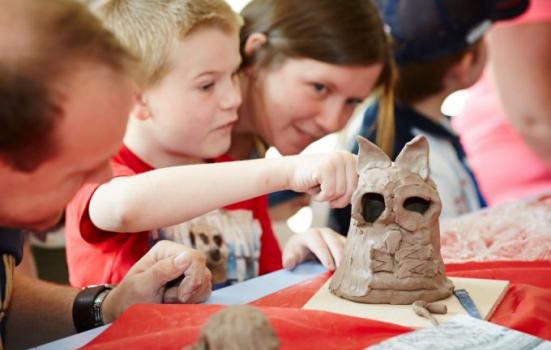Visual arts activities for young people are more important than ever, since the decline in the teaching of arts subjects in schools, says Jane Sillis.

Over the course of a week this June, around 15,000 children, young people and adults came together and enjoyed more than 100 creative events in galleries, museums, schools, arts and community centres across the UK as part of Children’s Art Week. Of the activities that took place, 85% were devised for families and provided a great introduction for those new to the visual arts, and an estimated 66% of participants were first-time attendees for the host venues. Family events included a world-record attempt to create the longest line of bunting at Compton Verney, Warwickshire, puppets, song, dance and craft activities at the People’s Museum in Manchester, and a mini art rave at Site Gallery, Sheffield, where participants created t-shirts and glowing crafts. Elsewhere, families worked with clay and explored local myths at Yorkshire Sculpture Park, made collages about happy, healthy cities at the Architecture Centre, Bristol and had their photographs taken inside the Photographers’ Gallery camera obscura.
Venues reported that there was an appetite among parents for more activities like Children’s Art Week
Through their involvement both adults and children were introduced to arts and cultural venues, learnt skills, met professional artists, explored issues and most importantly had fun together. Feedback from participating venues clearly demonstrated that families greatly enjoyed the experience of working on art activities together. Venues reported that there was an appetite among parents for more activities like Children’s Art Week, and in many cases families signed up for additional art workshops with the venues. Further comments gathered over the course of the week underlined how important the activity was in encouraging first-time visitors.
As the National Association for Gallery Education, we at engage are well aware of the numerous benefits that children and young people can gain through engaging with art and artists, evidenced by results from enquire. Enquire is our research programme and was part of the Department for Culture Media and Sport (DCMS) and Department for Education’s Strategic Commissioning Programme for Museums and Gallery Education 2014-11, and involved 40 galleries across England, in partnership with schools, artists and youth workers. It demonstrated that contemporary art can inform and develop high-quality and innovative learning experiences for young people. The research showed that young people also gain social benefits through working with artists and art including enhanced self-confidence and the ability to make decisions in groups and independently.
These positive outcomes are echoed in further studies undertaken by Ofsted and the DCMS (Drawing Together: Art, Craft and Design in Schools, April 2009), which demonstrated that interaction with art and artists enhances children and young people’s learning, their self confidence and decision-making skills.
However, the recent changes in formal education in England have made it increasingly difficult for artists to work in schools and for schools to visit arts and cultural organisations. Barriers for children and young people to studying the arts in England include the introduction of the English Baccalaureate, disincentives such as discount codes at GCSE, facilitating subjects at A level, fewer specialist teachers, and a paucity of subject-specific professional development for those teachers. Arts subjects have diminished in value, especially in the state sector. Research published by the Cultural Learning Alliance indicates that this has resulted in the withdrawal of arts subjects from the curriculum by 15%. It is clear that arts education in schools in England is under pressure, highlighted by artist Bob and Roberta Smith in his film Art Party, which was released on GCSE results day last month to underline his argument that “All schools should be art schools!”. As a result of this situation, for some children and young people their only experience of the arts will be out of school with their families. It is worth remembering the results of research carried out by the DCMS in 2012, which showed that children and young people from more deprived areas are the least likely to engage in the arts and culture.
We champion all opportunities for children and young people to access the visual arts both within and outside the school environment and will continue to run Children’s Art Week as a national event. We look forward to building on its success in the future and in 2015 plan to reach 37,000 participants and provide support for venues to plan and promote events. We will also encourage the use of Arts Award, in particular Arts Award Discover which is ideal for family-focused activities, and will deliver a national PR campaign with high-profile ambassadors including artists.
Jane Sillis is Director of engage.
www.engage.org



